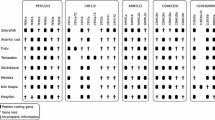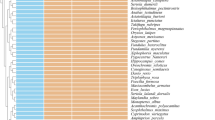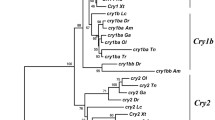Abstract
Period (Per) is a canonical circadian clock gene. The fruit fly, an invertebrate, has one per gene, while the human, a tetrapod vertebrate, has three Per genes. Per1, Per2, and Per3 of the tetrapods were generated from two rounds of ancient genome duplications from the ancestral chordate Per gene. Searching for five teleost fish genomes in a combination of phylogenetic, splicing site, and syntenic analyses revealed that zebrafish have two per1 genes, per1a and per1b, one per2, and one per3; medaka, fugu, and tetraodon each have two per2 genes, per2a and per2b, one per1, and one per3; sticklebacks also have per2a, per2b, and one per1 but lack per3; and per1a/per1b in zebrafish and per2a/per2b in madaka, fugu, tetraodon, and stickleback are ancient duplicates. While the dN/dS ratios of the five fish per duplicates are all <1, suggesting that they likely have been subject to purifying selection, the Tajima relative rate test showed that zebrafish per1a/per1b and fugu and medaka per2a/per2b have asymmetric evolutionary rates, implicating that one of these duplicates might have been under positive selection or relaxed functional constraint. Further, in situ hybridization showed that zebrafish per1a and per1b clearly have distinct patterns of temporal and spatial expression. These results support the notion that extra copies of teleost per genes were generated from the fish-specific genome duplication, and divergent resolution after the duplication resulted in retention of different per duplicates in different fish, most of which have diverged significantly.





Similar content being viewed by others
References
Albrecht U, Sun ZS, Eichele G, Lee CC (1997) A differential response of two putative mammalian circadian regulators, mper1 and mper2, to light. Cell 91:1055–1064
Amores A, Force A, Yan YL, Joly L, Amemiya C, Fritz A, Ho RK, Langeland J, Prince V, Wang YL, Westerfield M, Ekker M, Postlethwait JH (1998) Zebrafish hox clusters and vertebrate genome evolution. Science 282:1711–1714
Aparicio S, Chapman J, Stupka E, Putnam N, Chia JM, Dehal P, Christoffels A, Rash S, Hoon S, Smit A, Gelpke MD, Roach J, Oh T, Ho IY, Wong M, Detter C, Verhoef F, Predki P, Tay A, Lucas S, Richardson P, Smith SF, Clark MS, Edwards YJ, Doggett N, Zharkikh A, Tavtigian SV, Pruss D, Barnstead M, Evans C, Baden H, Powell J, Glusman G, Rowen L, Hood L, Tan YH, Elgar G, Hawkins T, Venkatesh B, Rokhsar D, Brenner S (2002) Whole-genome shotgun assembly and analysis of the genome of Fugu rubripes. Science 297:1301–1310
Bargiello TA, Jackson FR, Young MW (1984) Restoration of circadian behavioural rhythms by gene transfer in Drosophila. Nature 312:752–754
Bell-Pedersen D, Cassone VM, Earnest DJ, Golden SS, Hardin PE, Thomas TL, Zoran MJ (2005) Circadian rhythms from multiple oscillators: lessons from diverse organisms. Nat Rev Genet 6:544–556
Cahill GM (1996) Circadian regulation of melatonin production in cultured zebrafish pineal and retina. Brain Res 708:177–181
Cahill GM (2002) Clock mechanisms in zebrafish. Cell Tissue Res 309:27–34
Cahill GM, Hurd MW, Batchelor MM (1998) Circadian rhythmicity in the locomotor activity of larval zebrafish. Neuroreport 9:3445–3449
Cermakian N, Whitmore D, Foulkes NS, Sassone-Corsi P (2000) Asynchronous oscillations of two zebrafish CLOCK partners reveal differential clock control and function. Proc Natl Acad Sci USA 97:4339–4344
Christoffels A, Koh EG, Chia JM, Brenner S, Aparicio S, Venkatesh B (2004) Fugu genome analysis provides evidence for a whole-genome duplication early during the evolution of ray-finned fishes. Mol Biol Evol 21:1146–1151
Clayton JD, Kyriacou CP, Reppert SM (2001) Keeping time with the human genome. Nature 409:829–831
Cresko WA, McGuigan KL, Phillips PC, Postlethwait JH (2007) Studies of threespine stickleback developmental evolution: progress and promise. Genetica 129:105–126
Dehal P, Boore JL (2005) Two rounds of whole genome duplication in the ancestral vertebrate. PLoS Biol 3:e314
Delaunay F, Thisse C, Marchand O, Laudet V, Thisse B (2000) An inherited functional circadian clock in zebrafish embryos. Science 289:297–300
Delaunay F, Thisse C, Thisse B, Laudet V (2003) Differential regulation of Period 2 and Period 3 expression during development of the zebrafish circadian clock. Gene Expr Patterns 3:319–324
Dorus S, Vallender EJ, Evans PD, Anderson JR, Gilbert SL, Mahowald M, Wyckoff GJ, Malcom CM, Lahn BT (2004) Accelerated evolution of nervous system genes in the origin of Homo sapiens. Cell 119:1027–1040
Dunlap JC (1999) Molecular bases for circadian clocks. Cell 96:271–290
Force A, Lynch M, Pickett FB, Amores A, Yan YL, Postlethwait J (1999) Preservation of duplicate genes by complementary, degenerative mutations. Genetics 151:1531–1545
Friedman R, Hughes AL (2003) The temporal distribution of gene duplication events in a set of highly conserved human gene families. Mol Biol Evol 20:154–161
Gotter AL, Reppert SM (2001) Analysis of human Per4. Brain Res Mol Brain Res 92:19–26
Hardin PE (2005) The circadian timekeeping system of Drosophila. Curr Biol 15:R714–R22
He X, Zhang J (2005) Rapid subfunctionalization accompanied by prolonged and substantial neofunctionalization in duplicate gene evolution. Genetics 169:1157–1164
Hirayama J, Kaneko M, Cardone L, Cahill G, Sassone-Corsi P (2005) Analysis of circadian rhythms in zebrafish. Methods Enzymol 393:186–204
Hoegg S, Boore JL, Kuehl JV, Meyer A (2007) Comparative phylogenomic analyses of teleost fish Hox gene clusters: lessons from the cichlid fish Astatotilapia burtoni. BMC Genomics 8:317
Holland PW, Garcia-Fernandez J (1996) Hox genes and chordate evolution. Dev Biol 173:382–395
Hughes AL (1994) The evolution of functionally novel proteins after gene duplication. Proc Biol Sci 256:119–124
Jaillon O, Aury JM, Brunet F, Petit JL, Stange-Thomann N, Mauceli E, Bouneau L, Fischer C, Ozouf-Costaz C, Bernot A, Nicaud S, Jaffe D, Fisher S, Lutfalla G, Dossat C, Segurens B, Dasilva C, Salanoubat M, Levy M, Boudet N, Castellano S, Anthouard V, Jubin C, Castelli V, Katinka M, Vacherie B, Biemont C, Skalli Z, Cattolico L, Poulain J, De Berardinis V, Cruaud C, Duprat S, Brottier P, Coutanceau JP, Gouzy J, Parra G, Lardier G, Chapple C, McKernan KJ, McEwan P, Bosak S, Kellis M, Volff JN, Guigo R, Zody MC, Mesirov J, Lindblad-Toh K, Birren B, Nusbaum C, Kahn D, Robinson-Rechavi M, Laudet V, Schachter V, Quetier F, Saurin W, Scarpelli C, Wincker P, Lander ES, Weissenbach J, Roest Crollius H (2004) Genome duplication in the teleost fish Tetraodon nigroviridis reveals the early vertebrate proto-karyotype. Nature 431:946–957
Kasahara M, Naruse K, Sasaki S, Nakatani Y, Qu W, Ahsan B, Yamada T, Nagayasu Y, Doi K, Kasai Y, Jindo T, Kobayashi D, Shimada A, Toyoda A, Kuroki Y, Fujiyama A, Sasaki T, Shimizu A, Asakawa S, Shimizu N, Hashimoto S, Yang J, Lee Y, Matsushima K, Sugano S, Sakaizumi M, Narita T, Ohishi K, Haga S, Ohta F, Nomoto H, Nogata K, Morishita T, Endo T, Shin IT, Takeda H, Morishita S, Kohara Y (2007) The medaka draft genome and insights into vertebrate genome evolution. Nature 447:714–719
Kellis M, Birren BW, Lander ES (2004) Proof and evolutionary analysis of ancient genome duplication in the yeast Saccharomyces cerevisiae. Nature 428:617–624
Ko CH, Takahashi JS (2006) Molecular components of the mammalian circadian clock. Hum Mol Genet 15(Spec No 2):R271–R277
Kobayashi Y, Ishikawa T, Hirayama J, Daiyasu H, Kanai S, Toh H, Fukuda I, Tsujimura T, Terada N, Kamei Y, Yuba S, Iwai S, Todo T (2000) Molecular analysis of zebrafish photolyase/cryptochrome family: two types of cryptochromes present in zebrafish. Genes Cells 5:725–738
Kondrashov FA, Rogozin IB, Wolf YI, Koonin EV (2002) Selection in the evolution of gene duplications. Genome Biol 3:RESEARCH0008
Konopka RJ, Benzer S (1971) Clock mutants of Drosophila melanogaster. Proc Natl Acad Sci USA 68:2112–2116
Krumlauf R (1994) Hox genes in vertebrate development. Cell 78:191–201
Looby P, Loudon AS (2005) Gene duplication and complex circadian clocks in mammals. Trends Genet 21:46–53
Lynch M, Conery JS (2000) The evolutionary fate and consequences of duplicate genes. Science 290:1151–1155
Meyer A, Schartl M (1999) Gene and genome duplications in vertebrates: the one-to-four (-to-eight in fish) rule and the evolution of novel gene functions. Curr Opin Cell Biol 11:699–704
Meyer A, Van de Peer Y (2005) From 2R to 3R: evidence for a fish-specific genome duplication (FSGD). Bioessays 27:937–945
Naruse K, Fukamachi S, Mitani H, Kondo M, Matsuoka T, Kondo S, Hanamura N, Morita Y, Hasegawa K, Nishigaki R, Shimada A, Wada H, Kusakabe T, Suzuki N, Kinoshita M, Kanamori A, Terado T, Kimura H, Nonaka M, Shima A (2000) A detailed linkage map of medaka, Oryzias latipes: comparative genomics and genome evolution. Genetics 154:1773–1784
Nelson JS (2006) Fishes of the world. John Wiley & Sons, Hoboken, NJ
Ohno S (1970) Evolution by gene duplication. Springer-Verlag, New York
Panda S, Hogenesch JB, Kay SA (2002) Circadian rhythms from flies to human. Nature 417:329–335
Pando MP, Sassone-Corsi P (2002) Unraveling the mechanisms of the vertebrate circadian clock: zebrafish may light the way. Bioessays 24:419–426
Pando MP, Pinchak AB, Cermakian N, Sassone-Corsi P (2001) A cell-based system that recapitulates the dynamic light-dependent regulation of the vertebrate clock. Proc Natl Acad Sci USA 98:10178–10183
Panopoulou G, Poustka AJ (2005) Timing and mechanism of ancient vertebrate genome duplications—the adventure of a hypothesis. Trends Genet 21:559–567
Postlethwait JH (2007) The zebrafish genome in context: ohnologs gone missing. J Exp Zoolog B Mol Dev Evol 308:563–577
Postlethwait JH, Yan YL, Gates MA, Horne S, Amores A, Brownlie A, Donovan A, Egan ES, Force A, Gong Z, Goutel C, Fritz A, Kelsh R, Knapik E, Liao E, Paw B, Ransom D, Singer A, Thomson M, Abduljabbar TS, Yelick P, Beier D, Joly JS, Larhammar D, Rosa F, Westerfield M, Zon LI, Johnson SL, Talbot WS (1998) Vertebrate genome evolution and the zebrafish gene map. Nat Genet 18:345–349
Postlethwait J, Amores A, Cresko W, Singer A, Yan YL (2004) Subfunction partitioning, the teleost radiation and the annotation of the human genome. Trends Genet 20:481–490
Reddy P, Zehring WA, Wheeler DA, Pirrotta V, Hadfield C, Hall JC, Rosbash M (1984) Molecular analysis of the period locus in Drosophila melanogaster and identification of a transcript involved in biological rhythms. Cell 38:701–710
Semon M, Wolfe KH (2007) Reciprocal gene loss between Tetraodon and zebrafish after whole genome duplication in their ancestor. Trends Genet 23:108–112
Shearman LP, Zylka MJ, Weaver DR, Kolakowski LF Jr, Reppert SM (1997) Two period homologs: circadian expression and photic regulation in the suprachiasmatic nuclei. Neuron 19:1261–1269
Sordino P, van der Hoeven F, Duboule D (1995) Hox gene expression in teleost fins and the origin of vertebrate digits. Nature 375:678–681
Steinke D, Salzburger W, Braasch I, Meyer A (2006) Many genes in fish have species-specific asymmetric rates of molecular evolution. BMC Genomics 7:20
Stoltzfus A (1999) On the possibility of constructive neutral evolution. J Mol Evol 49:169–181
Sun ZS, Albrecht U, Zhuchenko O, Bailey J, Eichele G, Lee CC (1997) RIGUI, a putative mammalian ortholog of the Drosophila period gene. Cell 90:1003–1011
Tajima F (1993) Simple methods for testing the molecular evolutionary clock hypothesis. Genetics 135:599–607
Tamai TK, Carr AJ, Whitmore D (2005) Zebrafish circadian clocks: cells that see light. Biochem Soc Trans 33:962–966
Tamura K, Dudley J, Nei M, Kumar S (2007) MEGA4: Molecular Evolutionary Genetics Analysis (MEGA) software version 4.0. Mol Biol Evol 24:1596–1599
Tauber E, Last KS, Olive PJ, Kyriacou CP (2004) Clock gene evolution and functional divergence. J Biol Rhythms 19:445–458
Taylor JS, Van de Peer Y, Meyer A (2001) Genome duplication, divergent resolution and speciation. Trends Genet 17:299–301
Taylor JS, Braasch I, Frickey T, Meyer A, Van de Peer Y (2003) Genome duplication, a trait shared by 22000 species of ray-finned fish. Genome Res 13:382–390
Tei H, Okamura H, Shigeyoshi Y, Fukuhara C, Ozawa R, Hirose M, Sakaki Y (1997) Circadian oscillation of a mammalian homologue of the Drosophila period gene. Nature 389:512–516
Thompson JD, Gibson TJ, Plewniak F, Jeanmougin F, Higgins DG (1997) The CLUSTAL_X windows interface: flexible strategies for multiple sequence alignment aided by quality analysis tools. Nucleic Acids Res 25:4876–4882
Vallone D, Gondi SB, Whitmore D, Foulkes NS (2004) E-box function in a period gene repressed by light. Proc Natl Acad Sci USA 101:4106–4111
Van de Peer Y, Taylor JS, Braasch I, Meyer A (2001) The ghost of selection past: rates of evolution and functional divergence of anciently duplicated genes. J Mol Evol 53:436–446
Van de poele K, De Vos W, Taylor JS, Meyer A, Van de Peer Y (2004) Major events in the genome evolution of vertebrates: paranome age and size differ considerably between ray-finned fishes and land vertebrates. Proc Natl Acad Sci USA 101:1638–1643
von Schantz M, Jenkins A, Archer SN (2006) Evolutionary history of the vertebrate period genes. J Mol Evol 62:701–707
Wang H, Zhou Q, Kesinger JW, Norris C, Valdez C (2007a) Heme regulates exocrine peptidase precursor genes in zebrafish. Exp Biol Med (Maywood) 232:1170–1180
Wang W, Zhong J, Su B, Zhou Y, Wang YQ (2007b) Comparison of Pax1/9 locus reveals 500-Myr-old syntenic block and evolutionary conserved noncoding regions. Mol Biol Evol 24:784–791
Wang H, Kesinger JW, Zhou Q, Wren J, Martin G, Turner S, Tang Y, Frank B, Centola M (2008) Identification and characterization of ocular formation genes in zebrafish. Genome 51:243–257
Westerfield M (1995) The zebrafish book: guide for the laboratory use of zebrafish (Danio rerio). University of Oregon Press, Eugene
Whitmore D, Foulkes NS, Strahle U, Sassone-Corsi P (1998) Zebrafish Clock rhythmic expression reveals independent peripheral circadian oscillators. Nat Neurosci 1:701–707
Woods IG, Wilson C, Friedlander B, Chang P, Reyes DK, Nix R, Kelly PD, Chu F, Postlethwait JH, Talbot WS (2005) The zebrafish gene map defines ancestral vertebrate chromosomes. Genome Res 15:1307–1314
Yang Z (1997) PAML: a program package for phylogenetic analysis by maximum likelihood. Comput Appl Biosci 13:555–556
Yu W, Hardin PE (2006) Circadian oscillators of Drosophila and mammals. J Cell Sci 119:4793–4795
Zakany J, Duboule D (2007) The role of Hox genes during vertebrate limb development. Curr Opin Genet Dev 17:359–366
Ziv L, Gothilf Y (2006) Circadian time-keeping during early stages of development. Proc Natl Acad Sci USA 103:4146–4151
Ziv L, Levkovitz S, Toyama R, Falcon J, Gothilf Y (2005) Functional development of the zebrafish pineal gland: light-induced expression of period2 is required for onset of the circadian clock. J Neuroendocrinol 17:314–320
Acknowledgments
This study was supported by grants from the Whitehall Foundation (2002-12-103) and the Oklahoma Health Research Program (HR04-140S). I wish to thank Eric Lee for assistance with in situ hybridization experiments and image acquisition and analysis and David Durica and Rich Broughton for their helpful comments on an early version of the manuscript.
Author information
Authors and Affiliations
Corresponding author
Electronic supplementary material
Rights and permissions
About this article
Cite this article
Wang, H. Comparative Analysis of Period Genes in Teleost Fish Genomes. J Mol Evol 67, 29–40 (2008). https://doi.org/10.1007/s00239-008-9121-5
Received:
Revised:
Accepted:
Published:
Issue Date:
DOI: https://doi.org/10.1007/s00239-008-9121-5




